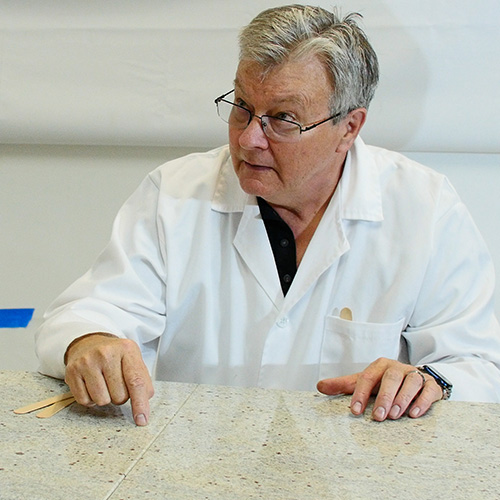The Science Behind Tile Grout Curing
Composition, Stages, and Factors
Frederick M Hueston | SR-Manual.com
Tile grout plays a crucial role in the durability, appearance, and waterproofing of tiled surfaces. Its curing process is a fascinating interplay of chemistry and physics that ensures tiles remain securely in place, resisting water and wear over time. This article delves into the science behind how tile grout cures, focusing on its composition, the curing process, and the factors that affect curing.
Composition of Tile Grout
Tile grout is primarily composed of a mixture of water, cement, and sand. Some formulations may also include fine aggregates, polymers, color pigments, and additives to improve water resistance, flexibility, and durability. The type of grout chosen (e.g., sanded, unsanded, epoxy-based) depends on the application, tile spacing, and desired properties.
The Curing Process
The curing process of tile grout is essentially a chemical reaction known as hydration, where water molecules react with Portland cement (the binder in grout) to form a hard, solid matrix. This process occurs in two main stages: setting and hardening.
Setting
Setting is the initial phase where the grout begins to stiffen but hasn’t yet reached its full strength. During this stage, the mixture transitions from a pliable paste to a more rigid structure. This happens as the cement particles react with water to form calcium silicate hydrate (C-S-H) and calcium hydroxide. These compounds start to interlock and form a crystalline structure, which binds the sand and any other components together. The setting time can vary based on the grout formulation, temperature, and humidity.
Hardening
Hardening follows the setting stage and can take several days to weeks, depending on the environment and type of grout. During hardening, the crystalline structures continue to grow and interconnect, further strengthening the grout. The continued hydration of cement particles contributes to this process, making the grout denser and more durable.
Factors Affecting Curing
Several external factors can influence the curing process of tile grout, including:
Moisture: Adequate moisture is crucial for the curing process. Too little water can halt the chemical reactions needed for curing, while too much can weaken the grout structure. Maintaining a balanced level of moisture throughout the curing period is essential for optimal strength and durability.
Temperature: Temperature significantly affects the rate of chemical reactions in the curing process. Higher temperatures can accelerate curing, while lower temperatures slow it down. Extremely high or low temperatures can adversely affect the structural integrity of the grout.
Air Humidity: The humidity level in the air can affect the evaporation rate of water from the grout. High humidity can slow the drying process, potentially leading to a stronger bond, whereas low humidity can cause the grout to dry too quickly, risking cracks and weak bonding.
Additives and Modifiers: The presence of polymers and other additives can modify the curing process. For instance, polymers can improve flexibility and water resistance, while certain additives can speed up or slow down the setting time to suit specific application needs.
Understanding the science behind the curing of tile grout highlights the importance of choosing the right grout for your tiling project and ensuring that it is applied under optimal conditions. Proper mixing, application, and curing of tile grout are essential to achieve a durable, attractive, and long-lasting tiled surface. The interplay of chemical reactions, environmental conditions, and material compositions makes the curing process a critical factor in the performance and lifespan of tiled areas.
The curing time for tile grout can vary significantly based on the type of grout used, environmental conditions, and specific product formulations. Generally, the curing process can be broken down into initial setting, final setting, and complete curing stages, each with its own timeline.
Initial Setting
The initial setting phase occurs within the first few hours after application, during which the grout begins to stiffen and lose its workability. This phase typically lasts between 30 minutes to a few hours, depending on the grout type and environmental conditions. During this time, the grout should not be disturbed.
Final Setting
After the initial setting, the grout enters the final setting stage, where it becomes hard to the touch but hasn’t yet reached its full strength. This stage usually occurs within 24 to 48 hours. While the grout may seem solid at this point, it’s still susceptible to damage from pressure or movement.
Complete Curing
Complete curing, where the grout achieves its maximum hardness and durability, takes longer. The general timelines for different types of grout to fully cure are as follows:
Cement-based grouts: Typically, cement-based grouts take about 7 to 10 days to cure under normal conditions. However, it can take up to 28 days for the grout to fully cure and achieve its maximum strength.
Epoxy grouts: Epoxy grouts have a faster curing process due to their chemical composition. They generally reach an initial cure within 24 hours and achieve complete curing within 7 days. However, they can handle light traffic within just a few hours after application.
Polymer-modified grouts: These grouts, enhanced with polymers for increased flexibility and bonding strength, may have varying curing times based on their specific formulations. Generally, they follow a similar curing timeline to cement-based grouts, requiring up to 7 to 14 days for complete curing.
Environmental Factors
Environmental conditions play a significant role in the curing process. High humidity and cooler temperatures can prolong the curing time, while warmer temperatures and moderate humidity can speed up the process. Manufacturers often recommend maintaining a temperature between 50°F (10°C) and 100°F (38°C) for optimal curing.
Practical Implications
For practical purposes, it’s essential to follow the manufacturer’s guidelines regarding foot traffic and water exposure. Some grouts may allow light foot traffic within 24 hours after application, but heavy traffic, cleaning, and full water exposure should be avoided until the grout has fully cured.
In summary, while the initial and final setting stages of grout curing happen relatively quickly, achieving complete curing and maximum strength takes significantly longer, ranging from a few days to several weeks. Adhering to manufacturer recommendations and considering environmental conditions are crucial for ensuring the durability and performance of the grouted tile surface.


